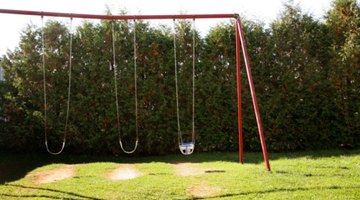How to Build a Playset on a Sloped Yard
Backyard playsets for children are available in pre-manufactured, painted steel kits or as an assortment of pressure-treated boards, posts and columns from local home and garden centers.

The kits include all hardware needed to install the playset, and normally can be completed in an afternoon by two people who have studied the instructions and have the right tools. These playsets are normally installed on flat and level ground, but in some cases a sloped yard can be used. The most important aspect of installing the playset is making sure the structure is firmly anchored to the ground.
Things You Will Need
- Playset kit, steel or pressure-treated lumber
- Socket wrench set
- Cordless drill with assorted drill bits, drill driver bits and screw driver bit tips
- Measuring tape
- Pencil
- 24” or 48” level (the longer the better)
- Bricks, cinder blocks or wooden blocks
- Shovel
- Post hole digger
- Contractor's reciprocating saw (sawsall)
- 40-lb bag quick-set concrete for each leg of the playset
- Bucket
- Water source
- Hoe
- 18-gal plastic mixing tub
Tip
Some wooden playsets have legs that are designed like inverted Ts rather than an A-frame. These playsets are designed to rest on top of the ground rather than be anchored with footings into the ground. Do not install this type of playset on sloping ground. Some metal playset structures are sold with stakes that anchor the legs into the ground. Do not rely on a mechanical anchor when building a playset on a sloping yard. For the structure to be stable, the legs should be cemented in the ground.
Laying Out the Play Structure
-
Assemble the play structure's main frame according to the manufacturer's instructions. With most playsets, the main frame is composed of two or three sets of legs bolted together into an A-frame. The sets of legs are joined at their apex by a central beam that runs the length of the play structure.
-
Position the play structure on the sloping yard in the proposed location. Evaluate the setting, and visually identify that the structure's legs can be buried into the ground in the proposed location.
-
Level the play structure by placing bricks or cinder blocks under the sets of legs that are on the downhill side of the slope. The main beam must be level in all directions, and must be centered between the A-frame legs. Any horizontal supports between the legs should also be level. Lift the legs on the downhill side of the structure as needed to make the structure rest level and plumb.
-
Measure the distance that the legs on the downhill side of the structure are above ground. This is the length by which the legs on the uphill side of the structure will be shortened.
-
Cut off the legs on the uphill side of the structure with the sawsall by the amount measured in the previous step.
-
After shortening the uphill legs, remove the bricks from all the legs. The play structure should now rest level on the ground. Visually verify that the installation can be completed. Step back, and view the playset from 360 degrees. Make sure that the planned installation will work in the area you have selected before digging holes in the ground.
Anchoring the Structure with Concrete Footings
-
Mark the locations of the legs on the ground with stakes, or by removing a small chunk of the sod with the shovel. Each of these locations will be a footing for the play structure. Move the play structure over a few feet to gain access to the footing locations.
-
Dig a hole at least 18 inches deep at each of the footing locations. In an area of the country where the ground freezes during the winter, the footing should be 24 inches deep.
-
Move the play structure back into place, and set one leg into each of the footing holes. Recheck the structure with the level to make sure that it is still level, adjusting the depth of any footing hole as necessary.
-
Mix one bag of concrete in the plastic tub for each footing hole. Mix the concrete one bag at a time, until the concrete is like a thick, stony toothpaste. Pour the entire bag into the hole in which the play structure's leg stands. Allow the cement to harden for 30 minutes, or according to the manufacturer's instructions on the bag. Then cover the hole with dirt. The structure is now firmly anchored to the ground; assembly can be completed.
The Drip Cap
- Backyard playsets for children are available in pre-manufactured, painted steel kits or as an assortment of pressure-treated boards, posts and columns from local home and garden centers.
- The main beam must be level in all directions, and must be centered between the A-frame legs.
- Measure the distance that the legs on the downhill side of the structure are above ground.
- The play structure should now rest level on the ground.
- Visually verify that the installation can be completed.
- Step back, and view the playset from 360 degrees.
- Pour the entire bag into the hole in which the play structure's leg stands.
References
Resources
Writer Bio
Since 2003, Timothy Burns' writing has appeared in magazines, management and leadership papers. He has contributed to nationally published books and he leads the Word Weavers of West Michigan writers' group. Burns wrote "Forged in the Fire" in 2004, and has published numerous articles online. As a trained conference speaker, Burns speaks nationally on the art, science and inspiration of freelance writing.
Photo Credits
- Jupiterimages/Photos.com/Getty Images
- Jupiterimages/Photos.com/Getty Images
More Articles



